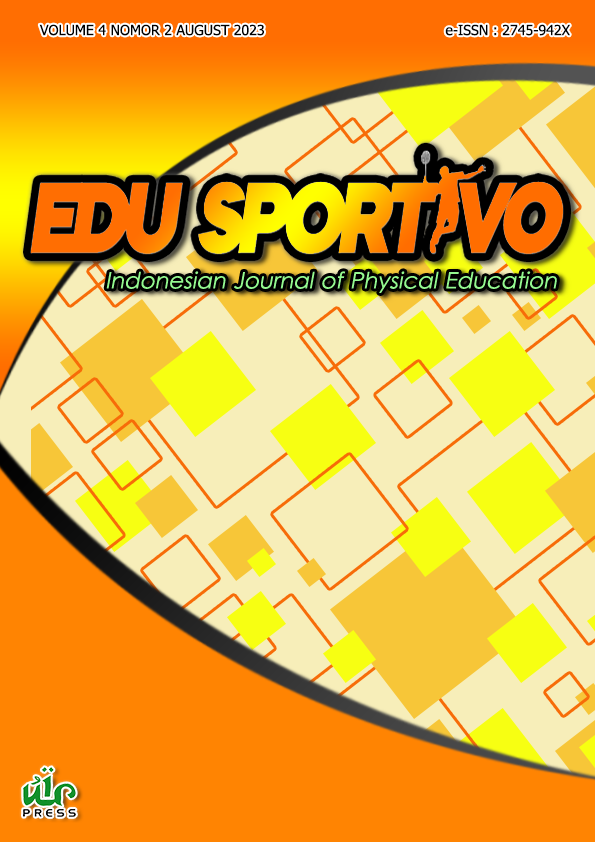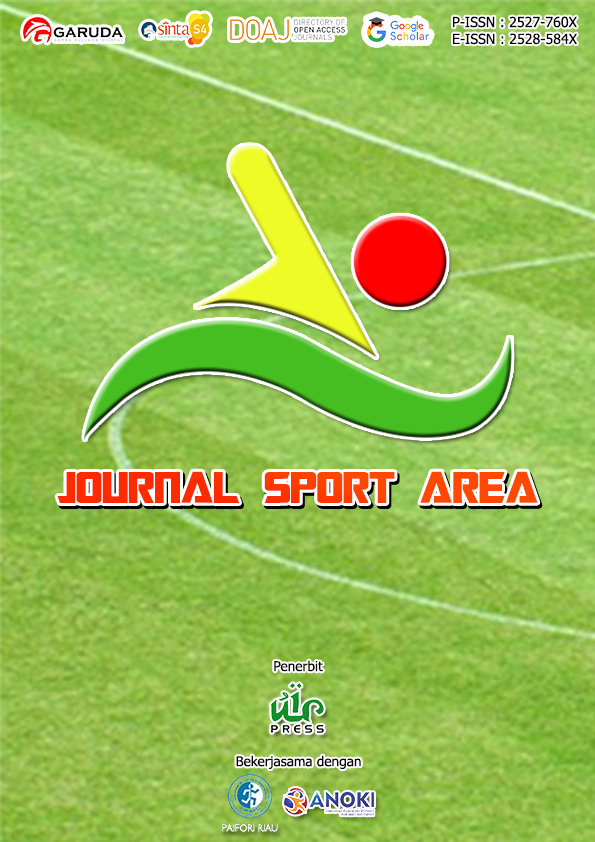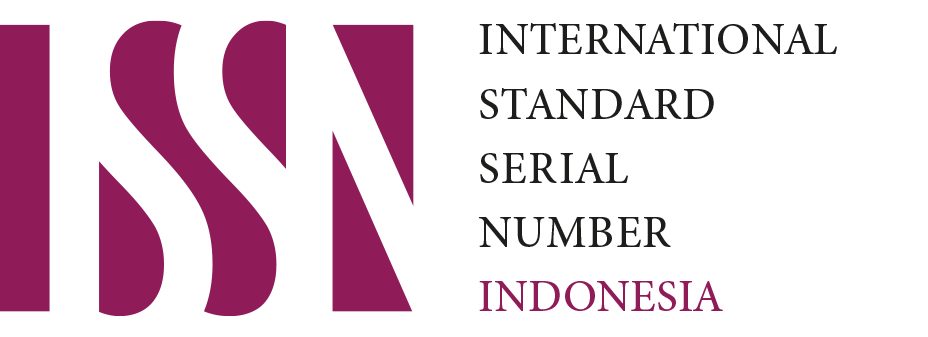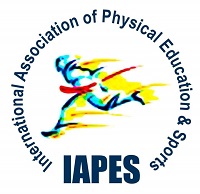Improving physical education in higher education institutions in the Philippines: Examining teachers' roles and perceptions in the implementation of CHED Memo No. 39, S. 2021
Keywords:
Physical education, teachers’ role and perception, PATHFITAbstract
This paper examined the implications of the Commission on Higher Education Memorandum Order No. 39, Series of 2021 on the roles and perceptions of physical education teachers. The study wants to gain a better understanding of the implications of the CHED memo on physical education teachers. This study employed a qualitative research approach in a phenomenological approach to understand the experiences of PE teachers with regards to the implementation of mentioned CMO. A purposive sample of 12 respondents made up of 9 males and 3 females were selected to answer the interview guide to gather the necessary data. Thematic analysis was the analytical techniques used to analyze the data. Ethical considerations were taken into account to ensure the trust and confidentiality of the respondents. The results revealed the positive impact of CMO 39 on higher learning institutions, including increased access to quality higher education for students, improved teaching, learning, research outcomes, and the development of a more inclusive environment. The research revealed that the implementation of the program was successful in terms of increasing student engagement and positive learning outcomes. It also highlighted the importance of teacher involvement in helping to create an effective learning environment for students. This research provides further evidence of the impact of teacher involvement in the successful implementation of educational programs, emphasizing the need for teacher support in order to ensure that students are able to achieve their learning goals.
Downloads
References
Adeyemo, K. S. (2019). Quality Improvement of Private Higher Education in the Philippines for ASEAN Integration. In Higher Education Policy in the Philippines and ASEAN Integration: Demands and Challenges. Brill. DOI: https://doi.org/10.1163/9789004411326
Alagül, Ö., & Gürsel, F. (2019). Teacher who (cannot) change: Experimental processes of physical education teachers by means of pedagogical innovations at the time of their professional development. Egitim ve Bilim, 44(197), 401–420. https://doi.org/10.15390/EB.2019.8016 DOI: https://doi.org/10.15390/EB.2019.8016
Alfrey, L., & Gard, M. (2014). A crack where the light gets in: A study of health and physical education teachers’ perspectives on fitness testing as a context for learning about health. Asia-Pacific Journal of Health, Sport and Physical Education, 5(1), 3–18. https://doi.org/10.1080/18377122.2014.867790 DOI: https://doi.org/10.1080/18377122.2014.867790
Aquino, J. M. (2022). Students’ evaluation in the developed video-based learning materials for physical education in Higher Education Institutions (HEIs). Edu Sportivo: Indonesian Journal of Physical Education, 111–124. https://doi.org/10.25299/es:ijope.2022.vol3(2).9428 DOI: https://doi.org/10.25299/es:ijope.2022.vol3(2).9428
Arslan, F. Y. (2019). The role of lesson study in teacher learning and professional development of EFL teachers in Turkey: A case study. TESOL Journal, 10(2), 1–13. https://doi.org/10.1002/tesj.409 DOI: https://doi.org/10.1002/tesj.409
Behl, A., Jayawardena, N., Pereira, V., Islam, N., Giudice, M. Del, & Choudrie, J. (2022). Gamification and e-learning for young learners: A systematic literature review, bibliometric analysis, and future research agenda. Technological Forecasting and Social Change, 176, 121445. https://doi.org/10.1016/J.TECHFORE.2021.121445 DOI: https://doi.org/10.1016/j.techfore.2021.121445
Braun, V., & Clarke, V. (2012). Thematic analysis. APA Handbook of Research Methods in Psychology, Vol 2: Research Designs: Quantitative, Qualitative, Neuropsychological, and Biological., 2, 57–71. https://doi.org/10.1037/13620-004 DOI: https://doi.org/10.1037/13620-004
Campbell, S., Greenwood, M., Prior, S., Shearer, T., Walkem, K., Young, S., Bywaters, D., & Walker, K. (2020). Purposive sampling: complex or simple? Research case examples. Journal of Research in Nursing: JRN, 25(8), 652. https://doi.org/10.1177/1744987120927206 DOI: https://doi.org/10.1177/1744987120927206
Chakraborty, M., & Muyia Nafukho, F. (2014). Strengthening student engagement: What do students want in online courses? European Journal of Training and Development, 38(9), 782–802. https://doi.org/10.1108/EJTD-11-2013-0123 DOI: https://doi.org/10.1108/EJTD-11-2013-0123
Culajara, C. J. (2022). Maximizing the Use of Google Sites in Delivering Instruction in Physical Education Classes. 1(2), 79–90. https://doi.org/10.56003/pessr.v1i2.115 DOI: https://doi.org/10.56003/pessr.v1i2.115
Docampo, L. G. (2021). [Reseña del libro] Primary and secondary education during Covid-19. Disruptions to Educational Opportunity During a Pandemic. Revista Iberoamericana de Educación, 87(2), 175–177. https://doi.org/10.35362/rie8724757 DOI: https://doi.org/10.35362/rie8724757
Doolittle, S. (2016). Engaging Middle School Students in Physical Education and Physical Activity Programs. Journal of Physical Education, Recreation & Dance, 87(6), 29–34. https://doi.org/10.1080/07303084.2016.1192940 DOI: https://doi.org/10.1080/07303084.2016.1192940
Flannery, K. B., Fenning, P., McGrath Kato, M., & McIntosh, K. (2014). Effects of school-wide positive behavioral interventions and supports and fidelity of implementation on problem behavior in high schools. School Psychology Quarterly, 29(2), 111–124. https://doi.org/10.1037/spq0000039 DOI: https://doi.org/10.1037/spq0000039
Fonte, R. J. B., Yazon, A. D., Tan, C. S., Buenvinida, L. P., & Bandoy, M. M. (2021). Distance Learning Delivery Modalities Implementation, Resilience Quotient, and Work Performance of Teachers: A Correlational Study in The Philippines. International Journal of Theory and Application in Elementary and Secondary School Education, 3(2), 171–181. https://doi.org/10.31098/IJTAESE.V3I2.684 DOI: https://doi.org/10.31098/ijtaese.v3i2.684
Jeong, H. C., & So, W. Y. (2020). Difficulties of online physical education classes in middle and high school and an efficient operation plan to address them. International Journal of Environmental Research and Public Health, 17(19), 1–13. https://doi.org/10.3390/ijerph17197279 DOI: https://doi.org/10.3390/ijerph17197279
Kallio, H., Pietilä, A. M., Johnson, M., & Kangasniemi, M. (2016). Systematic methodological review: developing a framework for a qualitative semi-structured interview guide. Journal of Advanced Nursing, 72(12), 2954–2965. https://doi.org/10.1111/jan.13031 DOI: https://doi.org/10.1111/jan.13031
Leeming, D. (2018). The Use of Theory in Qualitative Research. Journal of Human Lactation, 34(4), 668–673. https://doi.org/10.1177/0890334418794666
Major, L., & Watson, S. (2018). Using video to support in-service teacher professional development: the state of the field, limitations and possibilities. Technology, Pedagogy and Education, 27(1), 49–68. https://doi.org/10.1080/1475939X.2017.1361469 DOI: https://doi.org/10.1080/1475939X.2017.1361469
Marcaida, L. M., Gile, W. G. C., Tolentino, J. C. G., Carlos, C. O., Flores, J. D., & Cortez, G. A. D. (2022). Edu Sportivo: Indonesian Journal of Physical Education, 3(1), 85-99. https://doi.org/10.25299/es:ijope.2022.vol3(1).8883 DOI: https://doi.org/10.25299/es:ijope.2022.vol3(1).8883
Mishra, L. (2016). Focus Group Discussion in Qualitative Research. TechnoLearn: An International Journal of Educational Technology, 6(1), 1. https://doi.org/10.5958/2249-5223.2016.00001.2 DOI: https://doi.org/10.5958/2249-5223.2016.00001.2
Mohajan, H. K. (2018). Qualitative Research Methodology in Social Sciences and Related Subjects. Journal of Economic Development, Environment and People, 7(1), 23. https://doi.org/10.26458/jedep.v7i1.571 DOI: https://doi.org/10.26458/jedep.v7i1.571
Nguyen, T., Netto, C. L. M., Wilkins, J. F., Bröker, P., Vargas, E. E., Sealfon, C. D., Puthipiroj, P., Li, K. S., Bowler, J. E., Hinson, H. R., Pujar, M., & Stein, G. M. (2021). Insights Into Students’ Experiences and Perceptions of Remote Learning Methods: From the COVID-19 Pandemic to Best Practice for the Future. Frontiers in Education, 6, 91. https://doi.org/10.3389/FEDUC.2021.647986/BIBTEX DOI: https://doi.org/10.3389/feduc.2021.647986
Pangrazi, R. P., & Beighle, A. (2019). Dynamic physical education for elementary school children. Human Kinetics.
Piercy, K. L., Troiano, R. P., Ballard, R. M., Carlson, S. A., Fulton, J. E., Galuska, D. A., George, S. M., & Olson, R. D. (2018). The physical activity guidelines for Americans. JAMA - Journal of the American Medical Association, 320(19), 2020–2028. https://doi.org/10.1001/jama.2018.14854 DOI: https://doi.org/10.1001/jama.2018.14854
Plotnikoff, R. C., Costigan, S. A., Williams, R. L., Hutchesson, M. J., Kennedy, S. G., Robards, S. L., Allen, J., Collins, C. E., Callister, R., & Germov, J. (2015). Effectiveness of interventions targeting physical activity, nutrition and healthy weight for university and college students: A systematic review and meta-analysis. International Journal of Behavioral Nutrition and Physical Activity, 12(1), 1–10. https://doi.org/10.1186/s12966-015-0203-7 DOI: https://doi.org/10.1186/s12966-015-0203-7
Quennerstedt, M. (2019). Physical education and the art of teaching: transformative learning and teaching in physical education and sports pedagogy. Sport, Education and Society, 24(6), 611–623. https://doi.org/10.1080/13573322.2019.1574731 DOI: https://doi.org/10.1080/13573322.2019.1574731
Radina, N. K., & Balakina, J. V. (2021). Challenges for Education during the Pandemic: An Overview of Literature. Voprosy Obrazovaniya / Educational Studies Moscow, 2021(1), 178–194. https://doi.org/10.17323/1814-9545-2021-1-178-194 DOI: https://doi.org/10.17323/1814-9545-2021-1-178-194
Schumacher, D. J., Englander, R., & Carraccio, C. (2013). Developing the master learner: Applying learning theory to the learner, the teacher, and the learning environment. Academic Medicine, 88(11), 1635–1645. https://doi.org/10.1097/ACM.0b013e3182a6e8f8 DOI: https://doi.org/10.1097/ACM.0b013e3182a6e8f8
Seidel, T., Blomberg, G., & Renkl, A. (2013). Instructional strategies for using video in teacher education. Teaching and Teacher Education, 34, 56–65. https://doi.org/10.1016/j.tate.2013.03.004 DOI: https://doi.org/10.1016/j.tate.2013.03.004
Solmon, M. A. (2014). Physical Education, Sports, and Gender in Schools. Advances in Child Development and Behavior, 47, 117–150. https://doi.org/10.1016/BS.ACDB.2014.04.006 DOI: https://doi.org/10.1016/bs.acdb.2014.04.006
Sugawara, E., & Nikaido, H. (2014). Properties of AdeABC and AdeIJK efflux systems of Acinetobacter baumannii compared with those of the AcrAB-TolC system of Escherichia coli. Antimicrobial Agents and Chemotherapy, 58(12), 7250–7257. https://doi.org/10.1128/AAC.03728-14 DOI: https://doi.org/10.1128/AAC.03728-14
Suryawan, A. I., Mariah, Y. S., & Dyani, P. L. (2022). Improving Creativity Through Development of Dance Learning Models for Teachers in Junior High Schools in Bandung. Proceedings of the 4th International Conference on Arts and Design Education (ICADE 2021), 665(Icade 2021), 8–11. https://doi.org/10.2991/assehr.k.220601.003 DOI: https://doi.org/10.2991/assehr.k.220601.003
Sweeney, S. M., Hemler, J. R., Baron, A. N., Woodson, T. T., Ono, S. S., Gordon, L., Crabtree, B. F., & Cohen, D. J. (2020). Dedicated workforce required to support large-scale practice improvement. Journal of the American Board of Family Medicine, 33(2), 230–239. https://doi.org/10.3122/jabfm.2020.02.190261 DOI: https://doi.org/10.3122/jabfm.2020.02.190261
Tagare, R. L., & Villaluz, G. D. (2021). Probing the delivery of tertiary physical education among the generation Z students in the transition years of Philippine K to 12. International Journal of Physical Education, Sports and Health, 8(4), 355–359. https://doi.org/10.22271/kheljournal.2021.v8.i4f.2204 DOI: https://doi.org/10.22271/kheljournal.2021.v8.i4f.2204
Vengoechea, J., & Garcia, A. G. (2020). Intellectual and developmental disabilities. In Handbook of Clinical Adult Genetics and Genomics: A Practice-Based Approach. https://doi.org/10.1016/B978-0-12-817344-2.00016-2 DOI: https://doi.org/10.1016/B978-0-12-817344-2.00016-2
Winnick, J. P., & Porretta, D. L. (2017). Adapted Physical Education and Sport. Human Kinetics.
Yardley, S., Teunissen, P. W., & Dornan, T. (2012). Experiential learning: AMEE Guide No. 63. Medical Teacher, 34(2), 102–115. https://doi.org/10.3109/0142159X.2012.650741 DOI: https://doi.org/10.3109/0142159X.2012.650741
Published
How to Cite
Issue
Section
This is an open-access article distributed under the terms of the Creative Commons Attribution-ShareAlike 4.0 International License which permits unrestricted use, distribution, and reproduction in any medium. Users are allowed to read, download, copy, distribute, search, or link to full-text articles in this journal without asking by giving appropriate credit, provide a link to the license, and indicate if changes were made. All of the remix, transform, or build upon the material must distribute the contributions under the same license as the original.
Accepted 2023-03-25
Published 2023-07-27



.png)




















.png)







.png)





